| Ambystoma mavortium | |||||||||||||
| Ambystoma tigrinum | |||||||||||||
| Tiger Salamander | |||||||||||||
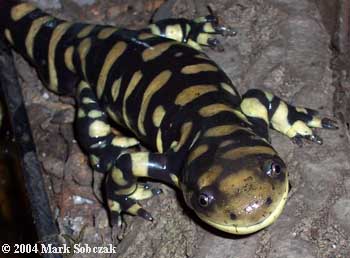
Ambystoma mavortium mavortium |
|
Description
Tiger salamanders are a complex of species and subspecies that include Ambystoma mavortium, Ambystoma tigrinum and others. Some of the species/subspecies of tiger salamander are:
Eastern tiger salamander (Ambystoma tigrinum)
The eastern tiger salamander is typified by yellow to olive spots or blotches on a brown to black background. The spotting can be highly variable depending on the population. Eastern tigers range from New York south along the eastern coat to Florida and west to Nebraska, Kansas, and Eastern Texas. They are absent from the Appalachian highlands.
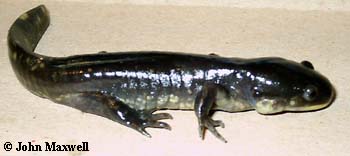 A. tigrinum. |
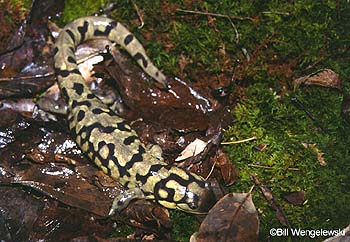 A. tigrinum with unusual coloration. |
Barred tiger salamander (Ambystoma mavortium mavortium)
The barred tiger salamander is characterized by tan to yellow vertical bars on a dark brown to black ground color. These bars vary in thickness depending on the population. They range from central Nebraska south to southern Texas and west to central Colorado and New Mexico.
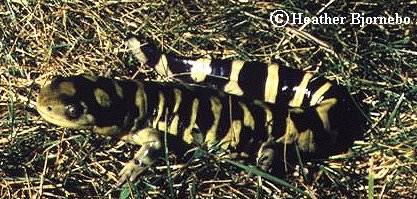
Ambystoma mavortium mavortiumArizona tiger salamander (Ambystoma mavortium nebulosum)
Arizona tiger salamanders are dark brown to black with yellow spots or markings. These markings are generally smaller and fewer than those of the barred tiger salamander. They are found from central Colorado and New Mexico westward to Utah and Arizona.Blotched tiger salamander (Ambystoma mavortium melanostictum)
These tiger salamanders usually have a netlike pattern of thin, dark markings or reticulations on a lighter ground color which can range from light olive to grey. They are slightly smaller on average than barred tiger salamanders. Blotched tiger salamanders are found from southern Alberta and southwest Saskatchewan south to northwest Colorado and Nebraska. There are also isolated populations in western Washington and eastern Idaho.
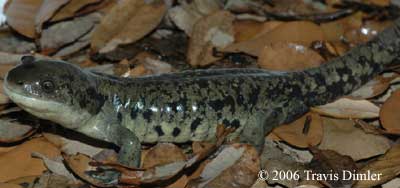
Ambystoma mavortium melanostictumGray tiger salamander (Ambystoma mavortium diaboli)
Gray tigers range in color from olive to brown with scattered dark spots on the sides and back. They are found from Saskatchewan and Manitoba south to South Dakota and extreme western Minnesota.
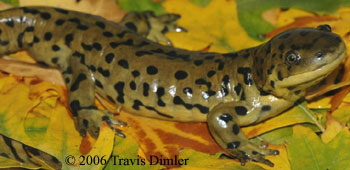
Ambystoma mavortium diaboliSonoran tiger salamander (Ambystoma mavortium stebbinsi)
Found only in the Huachuca and Patagonia Mountains of southeast Arizona, the Sonoran tiger salamander is highly variable in coloration, but individuals generally resemble either the barred tiger or the Arizona tiger. It is federally protected throughout its range.
Like other ambystomids, tiger salamanders spend a substantial portion of their adult life underground in either self-dug burrows or burrows dug by other organisms. With total lengths of up to 13.78 inches (35 cm), tiger salamanders have the distinction of potentially being the longest terrestrial salamander in the world.
Tiger salamanders are frequently sold as larvae called waterdogs (or "baby dinosaurs"). Waterdogs closely resemble the axolotl (Ambystoma mexicanum), and are sometimes sold incorrectly identified by this name. Waterdogs should not be confused with mudpuppies of the family Proteidae, for which they bear a superficial resemblance. A quick comparison in any good field guide will quickly show the differences between mudpuppies and larval tiger salamanders.
Identifying the subspecies of tiger salamanders purchased through the pet trade is usually impossible, as some of these salamanders are collected from localities that may have a natural intergradation of subspecies, or hybridization introduced through the escape of larvae used as bait. If you wish to know the exact subspecies purchased, attempts may be made to key out the subspecies using some of the references mentioned by Petranka (1998). Identifying larval tigers can be a frustrating task unless locality data is known. In many cases, identification must await metamorphosis.
Depending on the reference, there are up to six morphological variations of tiger salamanders (Petranka, 1998). Depending upon the subspecies in question, there can be normal gilled adults, cannibalistic gilled adults, normal transformed adults, cannibalistic transformed adults, large transformed adults and small transformed adults. The cannibalistic morph is known to occur in four of the subspecies and is typified by a wider broader head, a larger overall skull, and an extra row of provomerine teeth. Additionally, the cannibalistic morphs tend to reach a larger adult size than noncannabalistic morphs. Some populations have both large and small morphs, depending upon whether the breeding occurs in seasonally ephemeral pools or larger bodies of water that are less seasonally affected. The small morphs occur in areas with the seasonally ephemeral pools, transform at a smaller size, and reach a smaller total adult size.
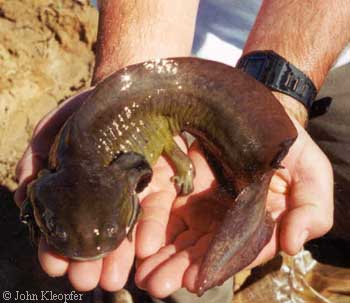
Huge neotenic (gilled adult) A. mavortium from a pond in Colorado.
Natural Range and Habitat
Tiger salamanders have the widest range of all the North American salamanders. Tiger salamanders may be found in scattered localities from portions of western-central Canada south into Mexico east and north to Long Island New York. Tiger salamanders inhabit areas that contain sandy or friable soils in a variety of habitats across North America. They are usually found near their breeding sites, which may consist of ditches, slow moving streams, cattle tanks, quarry ponds, spring-fed pools, and subalpine lakes. Rarely will they use any of these water sources if predatory fish are present.
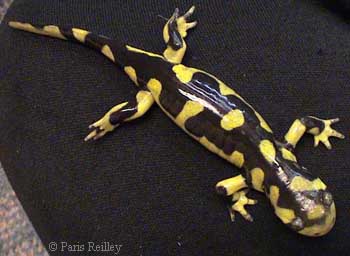 A. mavortium |
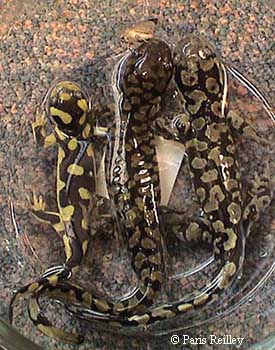 Three A. mavortium found in central Colorado, in an area of overlap between barred and blotched subspecies. |
Captive Care and Housing
Housing Larvae
Tiger salamanders are most commonly sold as large late-stage larvae. These larvae are primarily purchased from bait wholesalers and resold into the pet trade. Frequently these larvae have been starved for long periods of time and may be lacking fat reserves. Many of the larvae also have damaged gills or limbs due to bites from the other larvae. All potential acquisitions should be closely scrutinized to look for healthy animals with good weight and lacking sores or open wounds. The pelvic region should not be protruding nor should the belly be indented. The waterdog should be able to readily swim and be able to orient itself correctly. Animals that list to one side should be avoided. The animal should show a robust well-rounded appearance combined with a modest activity level. All aquatic larvae that are purchased should be transported in sufficient water to completely cover the waterdog. The number of larvae to be housed will determine the size of the aquarium required. I would recommend no more than one large larva per five gallons of water, as overcrowding reduces growth and may promote stress through aggressive interactions. All new acquisitions should be housed in a quarantine area by themselves for 60 days. This will also allow any stressed animals to acclimate and facilitate the rebuilding of the animals' fat reserves. Also, if desired, this will allow the animal to be screened for parasites through several fecal checks. The enclosure ideally should be as long and wide as possible instead of narrow and tall to allow sufficient floor space for the larvae. The enclosure should include visual barriers and one hiding spot for each larva to minimize aggression. Many of the decorations developed for fish tanks can be used for visual barriers and hiding spots. Do not house different sized larvae together, as this may result in cannibalism by the larger larva. It has been demonstrated that the cannibalistic morph only develops when different sized larvae are housed together. Ideally the aquarium should be cycled and have an established biological filter prior to the addition of the larva into the aquarium. If the aquarium does not have sufficient biological filtration, then ammonia and nitrite spikes will result. High levels of ammonia and nitrite are toxic and potentially lethal to aquatic amphibians. The water quality should be monitored to prevent toxic levels from being reached. If ammonia and nitrite levels are detected, water changes should be made with dechlorinated water. If necessary, the water changes may need to be conducted daily until the biological filter has become established. The aquarium should be unheated and not allowed to reach temperatures in excess of 75°F (23.9°C) with an ideal range between 65°F (18.3°C) to 72°F (22.2°C).
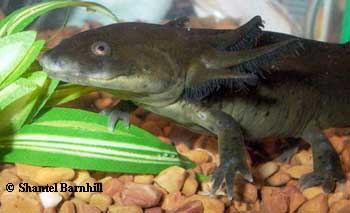
Larval tiger salamander (waterdog).
Feeding Larvae
Larval salamanders can be fed on redworms, earthworms, appropriately sized crickets, waxworms, guppies and minnows (not goldfish) and other available properly sized feeder invertebrates. Pieces of meat are acceptable as an occasional meal, but should not be used for the majority of the diet, as these items are deficient in essential vitamins and minerals. Do not use thawed frozen fish as a major portion of the diet as thiamin deficiency can result; additionally if the fish partially spoils prior to feeding, other vitamin deficiencies can result (Wright, 2001). As a supplement, some commercial pelleted foods are acceptable. As long as the temperatures do not fall below 65°F (18.3°C), most larva thrive on a diet offered two to three times a week. Lower temperatures are acceptable, but will result in reduced feeding. Food items should be offered until there is a decrease in active hunting behavior. As always, all uneaten food should be removed before it has a chance to spoil and pollute the water.
Care must be taken with newly purchased larvae. If the larva was starved for significant periods of time, then heavy feedings can kill the animal. After prolonged fasting, the larva will not be able to assimilate the food and may progress into shock and die. Frequent daily feedings of small, easily digested meals would be the best way to stabilize the animal. Pieces of earthworms are an excellent food that tends to be easily digested. Ideally, continue the small daily meals for several weeks to allow the animal to adjust to the feedings, then the schedule may be decreased while the amount of food offered at each feeding may be increased until food is only offered two to three times a week.
Care During Metamorphosis
Transformation to an adult will be indicated by the shortening and eventual absorption of the gills, reduction of the fins on the tail (the tail will lose some of the flat look and will thicken and become more rounded), and the beginning of the development of adult coloration. Full adult coloration can take several weeks to months to become fully established. As these signs become evident, the water level should be reduced, and the aquarium should either be tilted to allow access to a land area or an easily accessible land area should be provided. Unlike frogs and toads, the digestive tract does not undergo significant changes, so feeding should be continued during metamorphosis. However, some individuals will refuse food during this time. Due to the shallower water levels, feeding must be more closely monitored to prevent pollution of the water from uneaten food. After metamorphosis is complete, the salamander can be transferred to an adult setup.
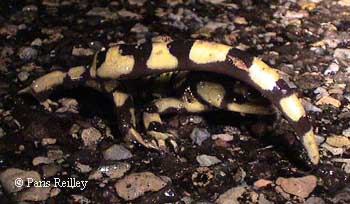 A. mavortium displaying unken reflex (defensive posture). |
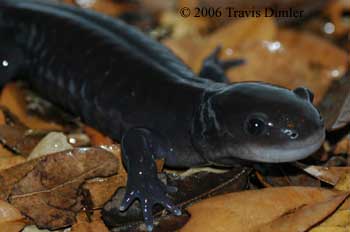 A. mavortium melanostictum, melanistic variant. |
Housing Adults
Adults can be maintained in a variety of enclosures depending on the keeper's wishes. The simplest enclosure is a large plastic storage box. Alternatively, the salamander can be housed in an aquarium or other enclosure that allows better viewing.
Substrates in tiger salamander enclosures should be moisture retentive to provide for adequate humidity to prevent desiccation of the salamander. There should ideally be a moisture gradient in the enclosure to allow the salamander to osmoregulate. This can be accomplished by sloping the substrate from one side of the enclosure to the other. All substrates used in terrestrial salamander enclosures should have the pH of the substrate checked prior to placing the salamander on the substrate. It has been shown that substrates with a low pH, like peat moss, may cause ion loss and eventual death of the animal. One option is moistened unbleached paper towels, with crumpled pieces of moist paper towels provide hiding areas to minimize stress. These bare enclosures are excellent for quarantine purposes and collection of fecal samples for parasite checks. To prevent accumulation of bacteria, paper toweling must be changed every few days, or when soiled. More natural substrates include moist topsoil, coconut fiber bedding, or commercially available "forest floor" soil mixes. Soil should be changed every one to two months, and feces removed daily. Warning: Do not use rocks or gravel of a size that can be swallowed; ingestion of gravel can occur during feeding, with fatal results.
If the salamanders have a substrate that does not allow them to burrow, then alternative hideouts need to be provided to relieve stress. If the keeper desires to observe the salamander in its burrow, then pieces of PVC tubing can be cut in half and placed with the cut side against the window with an entrance above the soil level. If the side of the tank is covered with dark paper, the salamanders will adopt the burrows, and the paper can be removed when observations are desired. A water bowl may or may not be necessary depending upon the moisture gradient in the soil. However a water bowl will help prevent deaths due to accidental desiccation, as the salamander will retreat to the water bowl if the soil becomes too dry. If a water bowl is included in the enclosure, then the water should be changed either when it is soiled or every few days with dechlorinated tap water.
As with the larvae, excessive temperatures should be avoided. Temperatures over 78°F (25.6°C) for extended periods of time are potentially life threatening. The best temperature range would be the same as for the larval salamanders.
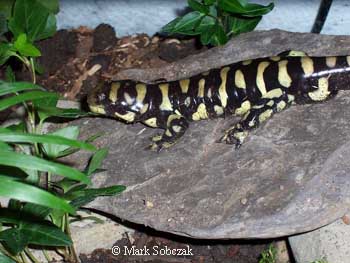 Adult tiger salamanders do best in terrestrial housing with hiding places and damp substrate where they can dig. |
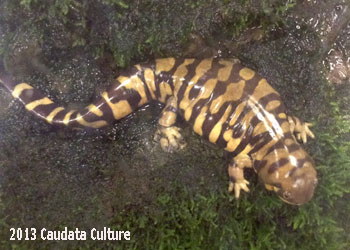 Adult tiger salamanders can become obese. |
Feeding Adults
The temperature of the enclosure will determine the frequency of feeding the salamander. If the temperature is 65°F (18.3°C) or cooler then the salamander may be fed once a week. At temperatures over 65°F (18.3°C), the salamander will need to be fed at least twice a week. The amount of food offered will also differ depending upon the temperature, with more food items being offered at warmer temperatures. Adult tiger salamanders will readily eat crickets, freshly shed mealworms, earthworms, caterpillars (e.g., wax worms, silk moth larvae), and pinky mice. Other than pinkies or wax worms, a good rule of thumb is to offer the salamander as much as it can eat in several hours or overnight. With pinkies or wax worms, these can be offered as an occasional treat or to fatten up a thin salamander, but because these food items contain high levels of fat, they should not be used as a steady diet. As a final caution, remove all uneaten crickets after 24 hours, as the crickets will bite and potentially harm or kill the salamander if left in the enclosure too long.
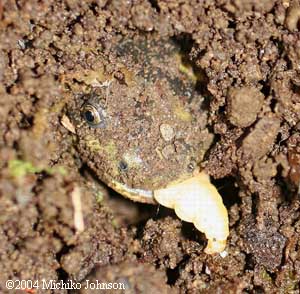
|
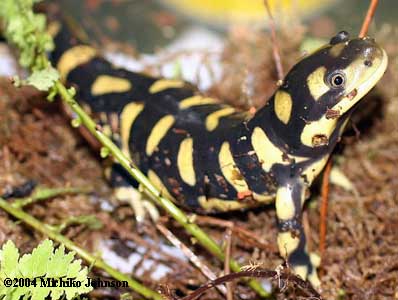
|
Breeding
The amount of time required to reach sexual maturity also depends on several factors: temperature, food supply, water conditions, crowding, and subspecies. The time frame can be as short as five months in seasonally ephemeral pools to as much as three years in some subalpine lakes.
Tiger salamanders have been documented breeding in most months of the year, with different subspecies having different breeding seasons. Breeding occurs after rains that trigger migration to breeding ponds. Males usually arrive at the sites before the females and leave after the females. Depending on the subspecies in question, the eggs may be deposited singly or in clusters on structures in the water or on the substrate of the breeding site. Eggs hatch in 19-50 days, depending upon subspecies and conditions at the breeding site.
At this time, there are few substantiated reports of captive breeding for any terrestrial forms of A. tigrinum or A. mavortium. As with most ambystomid salamanders, tigers breed by gathering in pools and other slow moving bodies of water in mass and communally courting and spawning. The trigger(s) for the spring spawning migration are poorly understood and require more research. It is possible to breed the neotenic adults in a manner similar to axolotls.
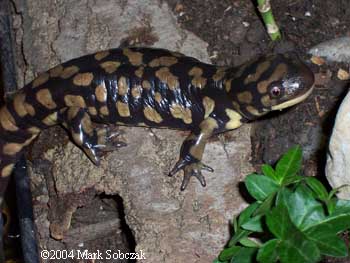 A. tigrinum |
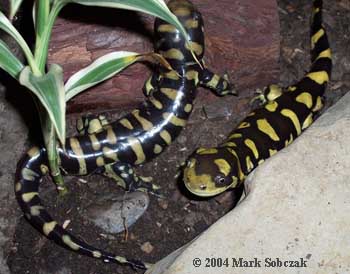 A. mavortium |
Conclusion
Tiger salamanders are an excellent salamander for the beginning caudate enthusiast as they readily feed upon easily procured food items and may be more forgiving of temperature extremes than some other easily available salamanders. Adding to their popularity, many of these animals recognize their keeper and may beg for food. Caution must be taken to avoid overfeeding and obesity. The personality of these endearing caudates will continue to make them a popular pet. (Note that tiger salamanders are not legal to keep as pets in the state of California; see entry for California tiger salamander.)
References
Conant, Roger; Collins, Joseph T.; 1991, A Field Guide to Reptiles and Amphibians of Eastern and Central North America, Houghton Mifflin Co., Boston.
Petranka, James W.; 1998, Salamanders of the United States and Canada, Smithsonian Institute Press, Washington.
Purser, Phillip; 2001, Tiger salamander, Reptile and Amphibian Hobbyist 6(10): 70-71.
Shaffer, H. Bradley; McKnight, Mark L.; 1996, The polytypic species revisited: genetic differentiation and molecular phylogenetics of the tiger salamander Ambystoma tigrinum (Amphibia: Caudata) complex. Ecology. 50 (1):417-433
Stebbins, Robert C.; 1985, A Field Guide to Western Reptiles and Amphibians, Houghton Mifflin Co., Boston.
Other Resources
CC article: Tiger Salamander 101
CC article: How Smart and How Social Is My Tiger Salamander? (PDF)
CC article: "Greeting" Behavior in Tiger Salamanders (PDF)
Axolotl.org article: Tiger Salamanders and Metamorphosed Axolotls.
© Ed Kowalski 2001
Written by Ed Kowalski, October 2001
Revised by Ed Kowalski, Jennifer Macke, and Nate Nelson, July
2002
